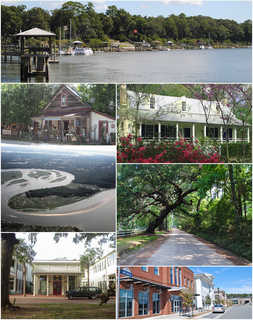
Bluffton is a town in Beaufort County, South Carolina, United States. It is primarily located around U.S. Route 278, between Hilton Head Island and Interstate 95. The Lowcountry town's original one square mile area, now known as Old Town, is situated on a bluff along the May River. The population as of the 2020 census was 27,716, an increase of over 120% since 2010, making it one of the fastest growing municipalities in South Carolina with a population over 2,500. Bluffton is the fifth largest municipality in South Carolina by land area. The town is a primary city within the Hilton Head Island-Bluffton-Beaufort, SC Metropolitan Statistical Area.

The South Carolina School for the Deaf and the Blind is a school in unincorporated Spartanburg County, South Carolina, United States, near Spartanburg and with a Spartanburg postal address. It was founded in 1849 by the Reverend Newton Pinckney Walker as a private school for students who were deaf. The School for the Blind was established in 1855, and the school became state funded in 1856.
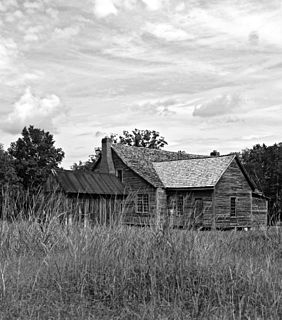
Bonham House, also known as Flat Grove, is a historic home located near Saluda, Saluda County, South Carolina. It was built about 1780, and is a two-story, log "dogtrot house." The house sits on fieldstone pillars. It was the boyhood home of Battle of the Alamo soldier James Bonham and his brother politician Milledge Luke Bonham, who served as governor of South Carolina during the American Civil War.

Horry-Guignard House is a historic home located at Columbia, South Carolina. It was built before 1813, and is a two-story, late Federal style, modified I-house type frame dwelling. The front facade features a one-story, full-width balustraded porch supported by square columns. During the winter of 1813–1814, the main hall was widened from six feet to eleven feet. To do this, the house was sawed in half and the two ends were pulled apart to rest on two new foundations. It was probably built by Peter Horry (1747-1815), a Revolutionary War Colonel and Brigadier General of the South Carolina Militia. Later, the house was acquired by John Gabriel Guignard (1751-1822), the Surveyor General of South Carolina from 1798 to 1802. Guignard is responsible for the early design of the city and laid out the first streets of Columbia.

Town Theatre is a historic community theatre located at Columbia, South Carolina. It was built in 1924, and is a rectangular brick building with a two-story glazed central arch with Art Deco influences. A brick annex was added to the rear of the building in the 1950s. It houses one of the first community theatres in the United States.

Bishop William Wallace Duncan House, also known as the DuPre House, is a historic home located at Spartanburg, Spartanburg County, South Carolina. It was designed by G. L. Norrman and built about 1886. It is a two-story, asymmetrical, clapboard and cedar shingled dwelling in the Queen Anne style. It has a high-pitched roof pierced by six chimneys, a decorative mosaic tile front porch landing, a massive wood shingle-clad cylindrical tower, and stained glass windows. It was moved from its original location at 249 N. Church St. to its present location in November 1999.
Ellerbe's Mill, also known as Millvale, is a historic grist mill complex located near Rembert, Sumter County, South Carolina. The mill was built about 1830, and is a 2 1/2-story pine clapboard building mounted on wooden pilings situated on a 90-acre millpond. Also located on the property is the associated store (1910); the two-story, frame Victorian style main house ; several tenant houses; and a dovecote.

Woodland Plantation is a historic plantation house and farm complex located near Carlisle, Union County, South Carolina, United States. It was built about 1850, and is a two-story, Greek Revival style clapboard structure. It features a front porch with square columns that have windows on all four sides. The complex includes buildings dating from 1850 to about 1950. They include a storehouse, a smokehouse, a carriage house, a bull pen, a cotton gin house, a privy, a hay barn, a calf barn, an office, a dairy milking parlor, and a silo.

Cross Keys House is a historic plantation house located at Cross Keys, Union County, South Carolina. It was built about 1812–1814, and is a two-story, five bay, brick Georgian Colonial style dwelling. It features a gabled roof with identical pairs of end chimneys, a massive raised first-story portico, and date stones carved with the date of the house's completion (1814), original owner's initials (B.B.), and crossed keys thought to be the insignia of the builder.
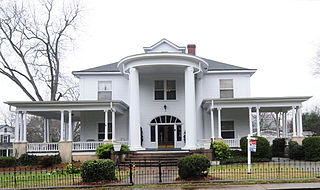
McWhirter House is a historic home located at Jonesville, Union County, South Carolina. It was built in 1909, and is a two-story, frame Classical Revival style dwelling. It features a full-height porch supported by classical columns, that is symmetrically balanced with side porches accented with classical detailing.

Culp House is a historic home located at Union, Union County, South Carolina. It was built about 1857, and is a two-story, brick structure, with Georgian and Neo-Classical design details. The front façade features a two-tiered, five-bay porch with Doric order columns.
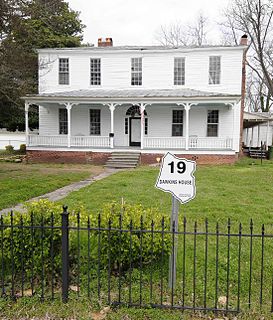
Judge Thomas Dawkins House, also known as The Shrubs, is a historic home located at Union, Union County, South Carolina. It was built about 1845, and is a two-story clapboard dwelling with a hipped metal roof. The front facade features a five-bay wide verandah supported by six chamfered columns. It was the residence of Judge Thomas Dawkins, a well-known political leader in Union County during and after the American Civil War.

Gov. Thomas B. Jeter House, also known as Sarratt House, is a historic home located at Union, Union County, South Carolina. It was built in 1859, and is a two-story, clapboard dwelling with Victorian detailing. It features a one-story front verandah and scalloped trim. It was the home of Thomas Bothwell Jeter, who served as the 79th Governor of South Carolina from September 1, 1880, to November 30, 1880.
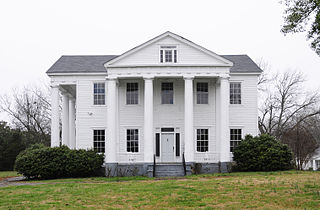
Meng House, also known as The Hill House and Clough-Wallace House, is a historic home located at Union in Union County, South Carolina, United States. It was built about 1832, and is a two-story, Greek Revival style frame dwelling. It features two two-story Doric order porticos supported by four stucco-over-brick columns. It has a two-story wing that houses the kitchen with bathrooms above.

Merridun is a historic home located at Union, Union County, South Carolina. It was built about 1855, and is a two-story, Georgian style frame dwelling. It features a massive two-storied Neoclassical portico with Corinthian order columns. It shelters a one-story verandah that extends partially around both sides of the house.

Herndon Terrace, also known as W.E. Thomson House, is a historic home located at Union, Union County, South Carolina. It was built about 1845–1848, and is a two-story, Greek Revival style frame dwelling. It features massive columned porticos on three sides, with solid brick columns covered with stucco. Also on the property are a once separate kitchen, that now adjoins the house, and an old slave cabin and cistern.

Union County Jail is a historic jail building located at Union, Union County, South Carolina. It is attributed to Robert Mills and built in 1823. It is a two-story, Palladian style granite ashlar structure. The structure has had two additions since 1900 and the interior has undergone extensive alteration.

Nathaniel Gist House is a historic home located near Union, Union County, South Carolina. It was built in 1855, and is a two-story, Greek Revival brick dwelling. It features a stuccoed white, brick-columned portico. Also on the property is a stone-lined circular well constructed with stones from the Broad River and capped with pecked granite slabs.

Wilson House, also known as Old Jail and Yorkville Jail, is a historic home located at York, York County, South Carolina. It is attributed to Robert Mills and was built in 1828. It is a three-story, brick building originally designed as a local jail. It features brick arches and a semi-circular fanlight. It was converted into a residence in 1853, then used as a jail during the Reconstruction Era when Federal troops imprisoned Ku Klux Klan members.

Willtown Bluff, also known as Wilton and New London, is a historic settlement site located on the S. Edisto River near Adams Run, Charleston County, South Carolina. Founded about 1704, it was the second planned town to be established after the relocation of Charleston in 1682. Willtown served as a local governmental center and regional commercial center. The property includes three early-19th century buildings: the Parsonage, the Willtown Plantation House, and the remains of a single column of the Episcopal church. Unexposed remains are of a colonial village thought to have had 80 houses.























